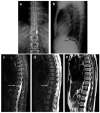Delay in diagnosis of thoracolumbar fractures
- PMID: 31210909
- PMCID: PMC6551460
- DOI: 10.4081/or.2019.7774
Delay in diagnosis of thoracolumbar fractures
Abstract
The time interval between the date of trauma and the diagnosis of vertebral column fractures hinders management and increases liability. We have examined the features and implications of this delay. 585 consecutive thoracolumbar fractures (2005-2016), were considered; 382 (65.30%) were males and 203 (34.70%) females. Mean age was 51 yr. Fall from a height (187; 31.97%), simple fall (147; 25.13%) and road accidents (111; 18.97%) were the most frequent causes of trauma. Physical exertion caused 8.38% (N=49). 142 patients (24.27%) were not diagnosed on the injury day (mean = 3.2 days). Delay was longer in females (mean = 5.5 vs. 2.7 days) and shorter in falls from a height (mean = 2.3) or road accidents (2.8). Mean age of diagnosed on the injury day differed from those diagnosed in the first month (49.2 vs 60.1). Plain X-ray signs were found in 7 misdiagnosed cases (46.6%). Delay was more frequent in low mineralization cases. Diagnostic delay of spine fractures is frequent. Some risk profiles can help to reduce it. Careful emergency X-ray examination is encouraged, as well as early magnetic resonance imaging in risk profiles.
Keywords: Diagnostic delay; Misdiagnosis; Osteoporosis; Vertebral fractures.
Conflict of interest statement
Conflict of interest: the authors declare no potential conflict of interest.
Figures

Similar articles
-
The impact of magnetic resonance imaging in the diagnostic and classification process of osteoporotic vertebral fractures.Injury. 2018 Nov;49 Suppl 3:S26-S31. doi: 10.1016/j.injury.2018.10.006. Injury. 2018. PMID: 30415666
-
Delayed Recognition of Thoracic and Lumbar Vertebral Compression Fractures in Minor Accident Cases.Cureus. 2017 Feb 23;9(2):e1050. doi: 10.7759/cureus.1050. Cureus. 2017. PMID: 28367388 Free PMC article.
-
[Effectiveness of pedicle screw fixation combined with non-fusion technology for treatment of thoracolumbar fracture through Wiltse paraspinal approach].Zhongguo Xiu Fu Chong Jian Wai Ke Za Zhi. 2014 Sep;28(9):1106-9. Zhongguo Xiu Fu Chong Jian Wai Ke Za Zhi. 2014. PMID: 25509775 Chinese.
-
Blunt Thoracolumbar-Spine Trauma Evaluation in the Emergency Department: A Meta-Analysis of Diagnostic Accuracy for History, Physical Examination, and Imaging.J Emerg Med. 2019 Feb;56(2):153-165. doi: 10.1016/j.jemermed.2018.10.032. Epub 2018 Dec 28. J Emerg Med. 2019. PMID: 30598296 Free PMC article. Review.
-
Classifying thoracolumbar fractures: role of quantitative imaging.Quant Imaging Med Surg. 2016 Dec;6(6):772-784. doi: 10.21037/qims.2016.12.04. Quant Imaging Med Surg. 2016. PMID: 28090452 Free PMC article. Review.
Cited by
-
Supplementary value and diagnostic performance of computed tomography scout view in the detection of thoracolumbar spine injuries.Emerg Radiol. 2024 Feb;31(1):63-71. doi: 10.1007/s10140-023-02196-9. Epub 2024 Jan 9. Emerg Radiol. 2024. PMID: 38194212
-
Suboptimal osteoporosis care in hospitalized patients: a retrospective analysis of vertebral compression fractures detected on computed tomography.Rheumatol Int. 2024 Nov;44(11):2599-2605. doi: 10.1007/s00296-024-05720-3. Epub 2024 Sep 17. Rheumatol Int. 2024. PMID: 39289216 Free PMC article.
-
Corrective osteotomy of global sagittal imbalance in the neglected fracture-dislocation thoracic spine.Trauma Case Rep. 2021 Feb 10;32:100409. doi: 10.1016/j.tcr.2021.100409. eCollection 2021 Apr. Trauma Case Rep. 2021. PMID: 33665306 Free PMC article.
-
Diagnostic accuracy of plain films in detection of thoracolumbar fractures in minor trauma patients: comparison with CT.Pol J Radiol. 2025 May 27;90:e260-e266. doi: 10.5114/pjr/204202. eCollection 2025. Pol J Radiol. 2025. PMID: 40626027 Free PMC article.
-
Sensitivity and specificity of machine learning and deep learning algorithms in the diagnosis of thoracolumbar injuries resulting in vertebral fractures: A systematic review and meta-analysis.Brain Spine. 2024 Apr 17;4:102809. doi: 10.1016/j.bas.2024.102809. eCollection 2024. Brain Spine. 2024. PMID: 38681175 Free PMC article. Review.
References
-
- Karlsson MK, Kherad M, Hasserius R, et al. Characteristics of prevalent vertebral fractures predict new fractures in elderly men. J Bone Joint Surg Am 2016;98:379-85. - PubMed
-
- Pongchaiyakul C, Nguyen ND, Jones G, et al. Asymptomatic vertebral deformity as a major risk factor for subsequent fractures and mortality: a longterm prospective study. J Bone Miner Res 2005;20:1349-55. - PubMed
-
- Bernstein M. Easily missed thoracolumbar spine fractures. Eur J Radiol 2010;74:6-15. - PubMed
LinkOut - more resources
Full Text Sources

